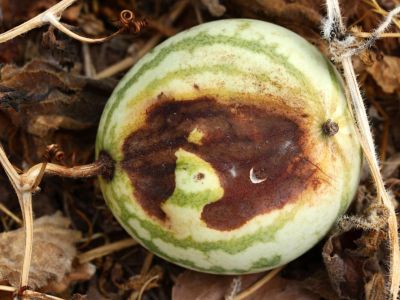Disease in Watermelon
Watermelons are generally pretty tough numbers, but once in a while they develop problems that can seem insurmountable. Treating watermelon problems is often a simple matter, but the first thing you’ve got to do is figure out what’s causing your problems. Look for these common watermelon diseases this summer:
Anthracnose – This seed-borne fungus is hard to detect initially, as it may only appear as small spots on your plants and fruits. As it grows, these spots expand and turn black or gray and new sunken areas may appear on your fruit. Crop rotation combined with an aggressive treatment of neem oil will help preserve this and future harvests from anthracnose. Bacterial Fruit Blotch – The bacterium Acidovorax avenae subspecies citrulli is often responsible for seedlings and young plants and fruits with water-soaked spots that spread and become necrotic. The leaves may brown, but the most dramatic sign is on fruit. The rind may crack and ooze a sticky, yellow liquid. Copper fungicide can control symptoms if it’s applied as soon as symptoms of bacterial fruit blotch are detected. Downy Mildew – Downy mildew is notable for the angular leaf spots it creates as it works its way through watermelon leaves. They may start as yellow areas, but soon turn brown with purple spores on the undersides of infected leaves. Fortunately, downy mildew won’t attack fruit, but it can reduce yields by weakening your plants. Neem oil can control this nasty mildew. Gummy Stem Blight – Older tissues are generally affected more often than new ones when gummy stem blight fungus is involved. Black, wrinkled spots on leaves and dark or sunken areas on stems and fruits are the first signs of disease. Under humid or wet conditions, affected plants rapidly collapse. Control is difficult, but copper fungicides can be effective if used as soon as gummy stem blight appears. Powdery Mildew – One of the most common diseases of plants in general, powdery mildew doesn’t spare watermelons. Leaves will appear to have a white powdery substance on them when the infection is active, though fruits aren’t generally affected. As the powdery mildew moves through the plant, leaves brown and die, leaving fruits to sunburn and weakening plants. Neem oil is an excellent treatment, but increasing air circulation around your watermelon plant by pruning can be equally effective.
